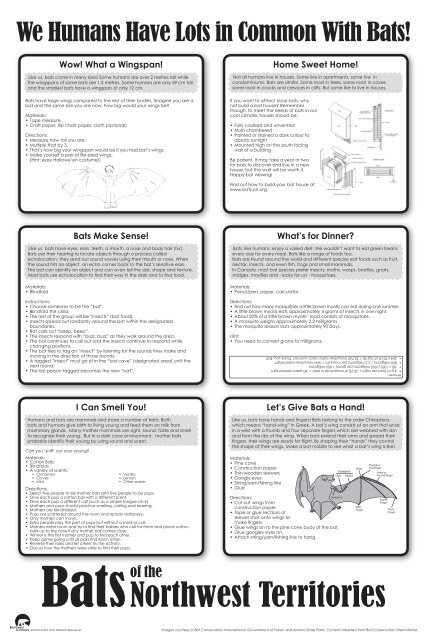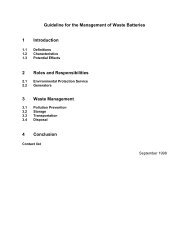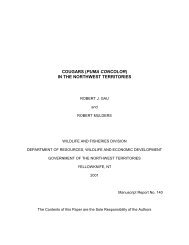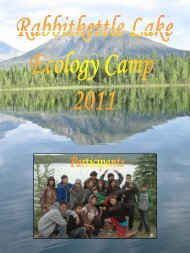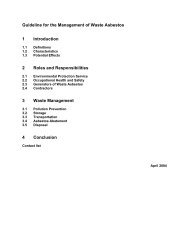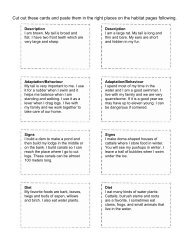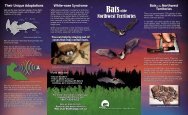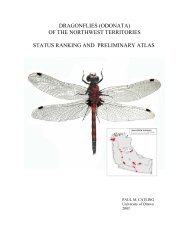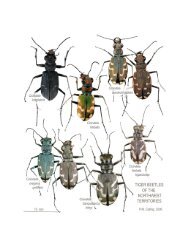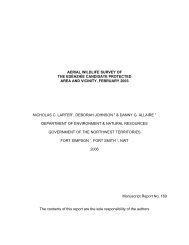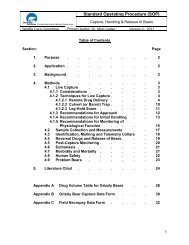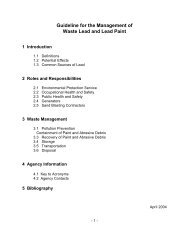Bats of the NWT poster
Bats of the NWT poster
Bats of the NWT poster
Create successful ePaper yourself
Turn your PDF publications into a flip-book with our unique Google optimized e-Paper software.
We Humans Have Lots in Common With <strong>Bats</strong>!<br />
Wow! What a Wingspan!<br />
Like us, bats come in many sizes! Some humans are over 2 metres tall while<br />
<strong>the</strong> wingspans <strong>of</strong> some bats are 1.5 metres. Some humans are only 59 cm tall<br />
and <strong>the</strong> smallest bats have a wingspan <strong>of</strong> only 12 cm.<br />
Home Sweet Home!<br />
Not all humans live in houses. Some live in apartments, some live in<br />
condominiums. <strong>Bats</strong> are similar. Some roost in trees, some roost in caves,<br />
some roost in cracks and crevices in cliffs. But some like to live in houses.<br />
<strong>Bats</strong> have large wings compared to <strong>the</strong> rest <strong>of</strong> <strong>the</strong>ir bodies. Imagine you are a<br />
bat and <strong>the</strong> same size you are now; how big would your wings be?<br />
Materials:<br />
• Tape measure<br />
• Craft paper, flip chart paper, cloth (optional)<br />
Directions:<br />
• Measure how tall you are.<br />
• Multiply that by 3.<br />
• That’s how big your wingspan would be if you had bat’s wings.<br />
• Make yourself a pair <strong>of</strong> life-sized wings.<br />
(Hint: easy Hallowe’en costume!)<br />
If you want to attract local bats, why<br />
not build a bat house? Remember<br />
though, to meet <strong>the</strong> needs <strong>of</strong> bats in our<br />
cool climate, houses should be:<br />
• Fully caulked and unvented<br />
• Multi-chambered<br />
• Painted or stained a dark colour to<br />
absorb sunlight<br />
• Mounted high on <strong>the</strong> south facing<br />
wall <strong>of</strong> a building<br />
Be patient. It may take a year or two<br />
for bats to discover and live in a new<br />
house, but <strong>the</strong> wait will be worth it.<br />
Happy bat viewing!<br />
Find out how to build your bat house at:<br />
www.batcon.org.<br />
Materials:<br />
• Blindfold<br />
<strong>Bats</strong> Make Sense!<br />
Like us, bats have eyes, ears, teeth, a mouth, a nose and body hair (fur).<br />
<strong>Bats</strong> use <strong>the</strong>ir hearing to locate objects through a process called<br />
echolocation; <strong>the</strong>y send out sound waves using <strong>the</strong>ir mouth or nose. When<br />
<strong>the</strong> sound hits an object, an echo comes back to <strong>the</strong> bat’s sensitive ears.<br />
The bat can identify an object and can even tell <strong>the</strong> size, shape and texture.<br />
Most bats use echolocation to find <strong>the</strong>ir way in <strong>the</strong> dark and to find food.<br />
Instructions:<br />
• Choose someone to be <strong>the</strong> “bat”.<br />
• Blindfold <strong>the</strong> child.<br />
• The rest <strong>of</strong> <strong>the</strong> group will be “insects” (bat food).<br />
• Insects spread out randomly around <strong>the</strong> bat within <strong>the</strong> designated<br />
boundaries.<br />
• Bat calls out “beep, beep”.<br />
• The insects respond with “buzz, buzz” as <strong>the</strong>y walk around <strong>the</strong> area.<br />
• The bat continues to call out and <strong>the</strong> insects continue to respond while<br />
changing positions.<br />
• The bat tries to tag an “insect” by listening for <strong>the</strong> sounds <strong>the</strong>y make and<br />
moving in <strong>the</strong> direction <strong>of</strong> those sounds.<br />
• A tagged “insect” must go sit in <strong>the</strong> “bat cave” (designated area) until <strong>the</strong><br />
next round.<br />
• The last person tagged becomes <strong>the</strong> new “bat”.<br />
What’s for Dinner?<br />
<strong>Bats</strong>, like humans, enjoy a varied diet. We wouldn’t want to eat green beans<br />
every day for every meal. <strong>Bats</strong> like a range <strong>of</strong> foods too.<br />
<strong>Bats</strong> are found around <strong>the</strong> world and different species eat foods such as fruit,<br />
nectar, insects, and even fish, frogs and small mammals.<br />
In Canada, most bat species prefer insects: moths, wasps, beetles, gnats,<br />
midges, mayflies and - lucky for us! - mosquitoes.<br />
Materials:<br />
• Pencil/pen, paper, calculator<br />
Directions:<br />
• Find out how many mosquitoes a little brown myotis can eat during one summer.<br />
• A little brown myotis eats approximately 4 grams <strong>of</strong> insects in one night.<br />
• About 20% <strong>of</strong> a little brown myotis’ food consists <strong>of</strong> mosquitoes.<br />
• A mosquito weighs approximately 2.2 milligrams.<br />
• The mosquito season lasts approximately 90 days.<br />
Hint:<br />
• You need to convert grams to milligrams.<br />
Answer:<br />
• 4 g <strong>of</strong> food per night x .20 (% <strong>of</strong> mosquitoes in diet) = .80 grams eaten/night<br />
• .80 x 1000 (1000 milligrams per gram) = 800 milligrams<br />
• 800 milligrams / 2.2 milligrams per mosquito = 364 mosquitoes eaten/night<br />
• 364 x 90 (# <strong>of</strong> nights) = 32,760 moquitoes eaten each summer! Thank you, Bat!<br />
Can you ‘sniff’ out your young?<br />
Materials:<br />
• Cotton Balls<br />
• Blindfolds<br />
• A variety <strong>of</strong> scents:<br />
• Cinnamon<br />
• Cloves<br />
• Mint<br />
I Can Smell You!<br />
Humans and bats are mammals and share a number <strong>of</strong> traits. Both<br />
bats and humans give birth to living young and feed <strong>the</strong>m on milk from<br />
mammary glands. Many mo<strong>the</strong>r mammals use sight, sound, taste and smell<br />
to recognize <strong>the</strong>ir young. But in a dark cave environment, mo<strong>the</strong>r bats<br />
probably identify <strong>the</strong>ir young by using sound and scent.<br />
• Vanilla<br />
• Lemon<br />
• O<strong>the</strong>r scents<br />
Directions:<br />
• Select five people to be mo<strong>the</strong>r bats and five people to be pups.<br />
• Give each pup a cotton ball with a different scent.<br />
• Give each pup a different call (such as a simple tongue-click).<br />
• Mo<strong>the</strong>rs and pups should practice smelling, calling and hearing.<br />
• Mo<strong>the</strong>rs are blindfolded.<br />
• Pups are scattered around <strong>the</strong> room and remain stationary.<br />
• Only mo<strong>the</strong>rs can move.<br />
• Extra people play <strong>the</strong> part <strong>of</strong> pups but without a smell or call.<br />
• Mo<strong>the</strong>rs enter room and try to find <strong>the</strong>ir babies who call for <strong>the</strong>m and place cotton<br />
balls up to <strong>the</strong> nose if any mo<strong>the</strong>r bat comes close.<br />
• Winner is <strong>the</strong> first mo<strong>the</strong>r and pup to find each o<strong>the</strong>r.<br />
• Keep game going until all pairs find each o<strong>the</strong>r.<br />
• Reverse <strong>the</strong>ir roles and let o<strong>the</strong>rs try <strong>the</strong> activity.<br />
• Discuss how <strong>the</strong> mo<strong>the</strong>rs were able to find <strong>the</strong>ir pups.<br />
Materials:<br />
• Pine cone<br />
• Construction paper<br />
• Thin wooden skewers<br />
• Googly eyes<br />
• String/yarn/fishing line<br />
• Glue<br />
Let’s Give <strong>Bats</strong> a Hand!<br />
Like us, bats have hands and fingers! <strong>Bats</strong> belong to <strong>the</strong> order Chiroptera,<br />
which means “hand-wing” in Greek. A bat’s wing consists <strong>of</strong> an arm that ends<br />
in a wrist with a thumb and four separate fingers which are webbed with skin<br />
and form <strong>the</strong> ribs <strong>of</strong> <strong>the</strong> wing. When bats extend <strong>the</strong>ir arms and spread <strong>the</strong>ir<br />
fingers, <strong>the</strong>ir wings are ready for flight. By shaping <strong>the</strong>ir “hands” <strong>the</strong>y control<br />
<strong>the</strong> shape <strong>of</strong> <strong>the</strong>ir wings. Make a bat mobile to see what a bat’s wing is like!<br />
Directions:<br />
• Cut out wings from<br />
construction paper.<br />
• Tape or glue sections <strong>of</strong><br />
skewer stick onto wings to<br />
make fingers.<br />
• Glue wings on to <strong>the</strong> pine cone body <strong>of</strong> <strong>the</strong> bat.<br />
• Glue googley eyes on.<br />
• Attach string/yarn/fishing line to hang.<br />
Forearm<br />
Ulna Radius<br />
Humerus<br />
Wrist<br />
Fifth<br />
Finger<br />
Thumb or<br />
First finger<br />
Index or<br />
Second finger<br />
Fourth<br />
Finger<br />
Third<br />
Finger<br />
<strong>Bats</strong><br />
<strong>of</strong> <strong>the</strong><br />
Northwest Territories<br />
Images courtesy <strong>of</strong> Bat Conservation International, Government <strong>of</strong> Yukon and Arizona State Parks. Content adapted from Bat Conservation International.


